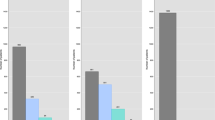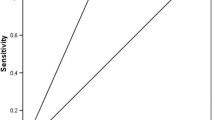Abstract
Background
The aim of this study was to evaluate the changes of arterial blood gas as a secondary insult in children and young adults suffering from severe traumatic brain injury, and to assess the correlation, if any, with their in-hospital mortality.
Method
In this cross-sectional study, the medical data of all children and adolescents with severe head trauma admitted to the Rasht Poursina Hospital were reviewed between April 2006 and September 2011. Data including age, gender, GCS upon admission, arrival and daily ABG values for the first 3 days, results of brain CT scan, as well as in-hospital mortality rate were collected. A logistic regression model was used to determine the association between acid–base disturbance and in-hospital mortality after adjustment for potential confounding factors.
Result
Of the 108 patients, 75 % were male and 25 % were female; and 31.5 % of them died in the hospital. Univariate analysis showed a significantly higher risk of mortality in patients who developed mixed metabolic acidosis plus respiratory acidosis on their admission day (OR = 3.94, p = 0.012). Multiple logistic regression analysis demonstrated that mixed metabolic acidosis plus respiratory acidosis (OR = 3.81, 95 % CI = 1.18–12.27, p-value = 0.025) and GCS (OR = 0.457, 95 % CI = 0.31–0.65, p-value < 0.001) were two significant predictors of mortality, regardless of other confounding variables.
Conclusion
The results of present study show that, in pediatric patients with severe head injuries, initial mixed metabolic acidosis plus respiratory acidosis and GCS are significant predictors of mortality, but other factors after adjustment for potential confounding factors had no prognostic effect.

Similar content being viewed by others
References
Alberico AM, Ward JD, Choi SC, Marmarou A, Young HF (1987) Outcome after severe head injury. Relationship to mass lesions, diffuse injury, and ICP course in pediatric and adult patients. J Neurosurg 67:648–656
Avarello JT, Cantor RM (2007) Pediatric Major Trauma: An Approach to Evaluation and Management. Emerg Med Clin North Am 25:803–836
Chesnut RM, Marshall LF, Klauber MR, Blunt BA, Baldwin N, Eisenberg HM, Jane JA, Marmarou A, Foulkes MA (1993) The role of secondary brain injury in determining outcome from severe head injury. J Trauma 34:216–222
Chi JH, Knudson MM, Vassar MJ, McCarthy MC, Shapiro MB, Mallet S, Holcroft JJ, Moncrief H, Noble J, Wisner D, Kaups KL, Bennick LD, Manley GT (2006) Prehospital hypoxia affects outcome in patients with traumatic brain injury: a prospective multicenter study. J Trauma 61:1134–1141
Clausen T, Khaldi A, Zauner A, Reinert M, Doppenberg E, Menzel M, Soukup J, Alves OL, Bullock MR (2005) Cerebral acid–base homeostasis after severe traumatic brain injury. J Neurosurg 103:597–607
Cochran A, Scaife ER, Hansen KW, Downey EC (2003) Hyperglycemia and Outcomes from Pediatric Traumatic Brain Injury. J Trauma Inj Infect Crit Care 55:1035–1038
Curley G, Kavanagh BP, Laffey JG (2010) Hypocapnia and the injured brain: more harm than benefit. Crit Care Med 38:1348–1359
Davis DP (2008) Early ventilation in traumatic brain injury. Resuscitation 76:333–340
Eberhard LW, Morabito DJ, Matthay MA, Mackersie RC, Campbell AR, Marks JD, Alonso JA, Pittet JF (2000) Initial severity of metabolic acidosis predicts the development of acute lung injury in severely traumatized patients. Crit Care Med 28:125–131
Facco E, Zuccarello M, Pittoni G, Zanardi L, Chiaranda M, Davia G, Giron GP (1986) Early outcome prediction in severe head injury: comparison between children and adults. Childs Nerv Syst 2:67–71
Van Putten HP, Bouwhuis MG, Muizelaar JP, Lyeth BG, Berman RF (2005) Diffusion-Weighted Imaging of Edema following Traumatic Brain Injury in Rats: Effects of Secondary Hypoxia. J Neurotrauma 22:857–872
Jones PA, Andrews PJ, Easton VJ, Minns RA (2003) Traumatic brain injury in childhood: intensive care time series data and outcome. Br J Neurosurg 17:29–39
Jones PA, Chambers IR, Minns RA, Lo TY, Myles LM, Steers AJ (2008) Are head injury guidelines changing the outcome of head injured children? A regional investigation. Acta Neurochir Suppl 102:81–84
King LR, McLaurin RL, Knowles HC Jr (1974) Acid–base balance and arterial and CSF lactate levels following human head injury. J Neurosurg 40:617–625
López Álvarez JM, Valerón Lemaur ME, Pérez Quevedo O, Limiñana Cañal JM, Bravo J, de Laguna A, Consuegra Llapurt E, Saén M, de Casas A, González Jorge R (2011) Severe pediatric head injuries (I). Epidemiology, clinical manifestations and course. Med Intensiva 36:331–336
McHugh GS, Engel DC, Butcher I, Steyerberg EW, Lu J, Mushkudiani N, Hernández AV, Marmarou A, Maas AIR, Murray GD (2007) Prognostic Value of Secondary Insults in Traumatic Brain Injury: Results from The IMPACT Study. J Neurotrauma 24:287–293
Moppett IK (2007) Traumatic brain injury: assessment, resuscitation and early management. Br J Anaesth 99:18–31
Muizelaar JP, Marmarou A, Ward JD, Kontos HA, Choi SC, Becker DP, Gruemer H, Young HF (1991) Adverse effects of prolonged hyperventilation in patients with severe head injury: a randomized clinical trial. J Neurosurg 75:731–739
Ong L, Selladurai BM, Dhillon MK, Atan M, Lye MS (1996) The prognostic value of the Glasgow Coma Scale, hypoxia and computerised tomography in outcome prediction of pediatric head injury. Pediatr Neurosurg 24:275–291
Philip S, Udomphorn Y, Kirkham FJ, Vavilala MS (2009) Cerebrovascular pathophysiology in pediatric traumatic brain injury. J Trauma 67:128–134
Sahin S, Bekar A, Doğan S, Kocaeli H, Aksoy K (2005) Critical care management of severe head injury in children. lus Travma Acil Cerrahi Derg 11:336–343
Seyed Saadat SM, Bidabadi E, Seyed Saadat SN, Mashouf M, Salamat F, Yousefzadeh S (2012) Association of persistent hyperglycemia with outcome of severe traumatic brain injury in pediatric population. Childs Nerv Syst 28:1773–1777
Signorini DF, Andrews PJ, Jones PA, Wardlaw JM, Miller JD (1999) Adding insult to injury: the prognostic value of early secondary insults for survival after traumatic brain injury. J Neurol Neurosurg Psychiatry 66:26–31
Subhas K, Appleby I (2011) Traumatic brain injury: initial resuscitation and transfer. Anaesthesia &. Intensive Care Med 12:201–203
Tran ND, Kim S, Vincent HK, Rodriguez A, Hinton DR, Bullock MR, Young HF (2010) Aquaporin-1-mediated cerebral edema following traumatic brain injury: effects of acidosis and corticosteroid administration. J Neurosurg 112:1095–1104
Tude Melo JR, Di Rocco F, Blanot S, Oliveira-Filho J, Roujeau T, Sainte-Rose C, Duracher C, Vecchione A, Meyer P, Zerah M (2010) Mortality in Children With Severe Head Trauma: Predictive Factors and Proposal for a New Predictive Scale. Neurosurgery 67:1542–1547
Vicario SJ, Coleman R, Cooper MA, Thomas DM (1983) Ventilatory status early after head injury. Ann Emerg Med 12:145–148
Werner C, Engelhard K (2007) Pathophysiology of traumatic brain injury. Br J Anaesth 99:4–9
Zebrack M, Dandoy C, Hansen K, Scaife E, Mann NC, Bratton SL (2009) Early Resuscitation of Children with Moderate-to-Severe Traumatic Brain Injury. Pediatrics 124:56–64
Zupping R (1970) Cerebral acid–base and gas metabolism in brain injury. J Neurosurg 33:498–505
Conflict of interest
The authors declare that there is no conflict of interest.
Author information
Authors and Affiliations
Corresponding author
Rights and permissions
About this article
Cite this article
Rahimi, S., Bidabadi, E., Mashouf, M. et al. Prognostic value of arterial blood gas disturbances for in-hospital mortality in pediatric patients with severe traumatic brain injury. Acta Neurochir 156, 187–192 (2014). https://doi.org/10.1007/s00701-013-1929-0
Received:
Accepted:
Published:
Issue Date:
DOI: https://doi.org/10.1007/s00701-013-1929-0




